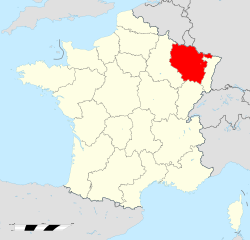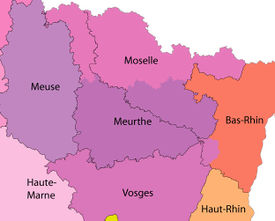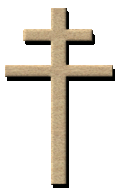Lorraine (region)
| Lorraine | |||
|---|---|---|---|
| — Region of France — | |||
|
|||
 |
|||
| Country | France | ||
| Prefecture | Metz | ||
| Departments | |||
| Government | |||
| - President | Jean-Pierre Masseret (PS) | ||
| Area | |||
| - Total | 23,547 km2 (9,091.5 sq mi) | ||
| Population (2007-01-01) | |||
| - Total | 2,343,000 | ||
| - Density | 99.5/km2 (257.7/sq mi) | ||
| Time zone | CET (UTC+1) | ||
| - Summer (DST) | CEST (UTC+2) | ||
| NUTS Region | FR4 | ||
| Website | lorraine.eu | ||

Lorraine (French pronunciation: [lɔʁɛn]; German: Lothringen; Lorrain: Louréne) is one of the 26 régions of France. The administrative region has two cities of equal importance, Metz and Nancy. Metz is considered to be the official capital since that is where the regional parliament is situated. The region's name is derived from the medieval Lotharingia.
The region consists of four departments: Meurthe-et-Moselle, Meuse, Moselle and Vosges and contains 2,337 communes.
Contents |
Administrative history
The borders of the area called Lorraine changed much in its long history. In 843, Charlemagne had died, and the Holy Roman Empire was divided among his three grandsons. One of them was Lothar, and his realm, reaching from Frisia to Rome, was called Lotharingia. In 870, it was decided that the realm should be a duchy within the kingdom of East Francia. In 962, when Otto the Great restored the Empire (restauratio imperii), Lorraine remained a duchy within the Holy Roman Empire until 1766.
Lotharingia experienced great prosperity during the 12th and 13th centuries under the Hohenstaufen emperors, but this prosperity was terminated in the 14th century by a series of harsh winters, bad harvests, and the Black Death. During the Renaissance, prosperity returned to Lothringia under Habsburg administration, until the Thirty Years' War 1766 until 1871 Lorraine remained a part of France, and was the cause of much revisionism. The population was mixed, but still largely German-speaking. Nationalism only had begun to replace the feudalist system which had formed the borders. But the resurrection against the French occupation influenced much of the early German identity, which before was divided into regional identities like the Bavarians, Saxons, Frisians and many more. From 1871, the German Empire regained a part of the Lorraine region (corresponding to the current Moselle department), until it lost the First World War; still, the Lorrainians were by then not embracing the union with the Empire, but rather would have preferred remaining a part of France.[1] It was called the Imperial Province Elsaß-Lothringen, which created a revisionist movement in France as well. In the 1918 Versailles treaty, the Empire suffered severe territorial (and other) losses including Elsaß and Lothringen. With the exception of the Second World War 1939-1945, the area remained a part of France, and the administration strongly discouraged German language and culture over French. It became the administrative language, and the only language in schools. Most Germans left the area after both wars, but even those that remain do not desire a union with the Federal Republic of Germany, even the few that desire autonomy for the region. There are still many names of places, towns and streets in German, like Phalsbourg/Pfalzburg, Petite-Rosselle/Kleinrosseln, Sarreguemines/Saargemünd...
Development of the borders of Lorraine in modern history

The région of Lorraine is larger than the historical duchy of Lorraine, which gradually came under French sovereignty between 1737 and 1766. The modern région includes provinces and areas that were historically separate from the duchy of Lorraine proper. These are:
- Barrois
- Three Bishoprics: non-contiguous territories around Metz, Verdun, and Toul which were detached from the Holy Roman Empire in the 16th century and came under French sovereignty.
- several small principalities which were still part of the Holy Roman Empire at the time of the French Revolution.
Some people consider the traditional province of Lorraine as limited to the duchy of Lorraine proper, while other people consider that it includes Barrois and the Three Bishoprics. The problem is that this duchy of Lorraine was originally the duchy of upper Lorraine, and did not include the entire area called Lorraine.
The case of Barrois is the most complicated: the western part of Barrois (west of the Meuse River), known as Barrois mouvant, was detached from the rest of Barrois in the early 14th century and passed under French sovereignty. On the other hand, the largest part of Barrois (east of the Meuse River) was the Duchy of Bar, part of the Holy Roman Empire, which was united with the duchy of Lorraine in the 15th century by the marriage of the Duke of Bar, René I of Naples, with the daughter of the Duke of Lorraine, Isabella. Thus the duchies of Bar and Lorraine were united in personal union under the same duke, although formally they maintained separate existences until their incorporation into France in 1766.
During the French Revolution, four départements were created on the main parts of the territories of Barrois, Three Bishoprics and the Duchy of Lorraine: Meuse, Meurthe, Moselle and Vosges. After 1870 some parts of Moselle and Meurthe became German and the parts that stayed French formed the new Meurthe et Moselle. After 1918 Moselle became French again. When the French régions were created in the middle of the 20th century, it was decided to gather Meurthe et Moselle, Meuse, Moselle and Vosges into a single region, simply called "Lorraine".
Geography

Lorraine is the only French region to have borders with three other countries: Belgium (Wallonia), Luxembourg, and Germany (Saarland, Rhineland-Palatinate). It also borders the French regions of Franche-Comté, Alsace, and Champagne-Ardenne. The location of Lorraine led to it being seen as a strategic asset and as the crossroads of four nations, it had a very important role in European affairs. Many rivers run through Lorraine, including Moselle, Meurthe, and Meuse.
Language and culture
Most of Lorraine has a clear French identity. Bismarck only annexed about a third of today's Lorraine to the German Empire following the Franco-Prussian War. The disputed third, known as Moselle, had a culture not easily classifiable as either French or German, possessing both Romance and Germanic dialects. Like many border regions, Lorraine was a patchwork of ethnicities and dialects, sometimes not even mutually intelligible with either French or German.
Despite the French government's "single language" policy, local Germanic dialects still survive in the northern part of the region. They are known as a whole as Lorraine Franconian in English, francique or platt (lorrain) in French (not to be confused with lorrain, the Romance dialect spoken in the region). These dialects are distinct from the neighbouring Alsatian language, to the south, although the two are often confused. Neither has any form of official recognition. Historically, there are two dialect families spoken in Germanic Lorraine. Both Moselle and Lorraine Franconian are spoken in the region. They are similar to the dialects native to the neighboring west central German dialects spoken in Luxembourg and Germany.
Like most of France's regional languages (such as Breton, the West Flemish dialect of Dutch, Catalan, Provençal and Alsatian), Lorraine and Moselle Franconian German have been largely replaced by French since the advent of mandatory public schooling in the 19th and 20th centuries. However, there are efforts underway to preserve the dialects and many older people still speak them. Recent efforts include the use of bi-lingual signage in parts of German dialect speaking France and language classes for young children.
Cross of Lorraine

During World War II, the cross was adopted as the official symbol of the Free French Forces (French: Forces Françaises Libres, or FFL) under Charles de Gaulle.
The capitaine de corvette Thierry d'Argenlieu suggested the adoption of the Cross of Lorraine as the symbol of the Free French, both to recall the perseverance of Joan of Arc (whose symbol it had been), and as an answer to the Swastika.
In his General Order n° 2 of 3 July 1940, vice-admiral Émile Muselier, then chief of the naval and air forces of the Free French for only two days, created the bow flag displaying the French colours with a red Cross of Lorraine, and a cockade also featuring the Cross of Lorraine.
De Gaulle is memorialised by a gigantic 43-meter high Cross of Lorraine at his home village of Colombey-les-Deux-Églises.
Cuisine

The use of the potato in Lorraine can be traced back to 1665 and it is used in various traditional dishes of the region such as the potée lorraine. The Breux potato, which takes its name from the village of Breux in the north of the Meuse, is considered to be excellent by experts due to the perfect conditions of the area. Smoked bacon is also a traditional ingredient of the cuisine of Lorraine. It is used in various traditional dishes of the region, including the famous quiche lorraine. The mirabelle plum of Lorraine is the emblematic fruit of Lorraine. It is used in pies and other desserts, as well as in alcoholic beverages.
Traditional dishes in the region include:
- Quiche lorraine
- Pâté lorrain (chopped pork and veal flavoured with white wine and baked in puff pastry)
- Potée lorraine (a stew of smoked meats and sausages, with cabbage and root vegetables)
- Andouille (tripe sausage)
Beverages
- Wine: The most well-known wine of the region is the pinot noir of Toul. There are vineyards in the valley of the Moselle, the valley of Seille, the valley of Metz, and the valley of Sierck.
- Beer: Historically, Lorraine was the location of many breweries, including the Champigneulles
Economy
With 44 billion euros, Lorraine generates 3.4% of France's GDP, and ranks 8th out of the 26 regions of France. The logistics and service sectors have experienced the strongest growth in recent years while the traditional industries (textiles, mining, metallurgy) have experienced a decline and consequently the region has experienced a major difficulty with a rising unemployment rate that is near the national average. In 1997 the last iron ore mine in Lorraine, which once produced over 50 million tonnes of iron, was closed.[2]
| Lorraine | France | |
|---|---|---|
| GDP 2000 | 44.3 Billion Euros | 1.816 Trillion Euros |
| Agriculture | 2.5% | 2.8% |
| Industry | 30.7% | 25.6% |
| Service | 66.8% | 71.6% |
| Unemployment June 2002 | 8.4% | 9% |
Major communities
- Épinal
- Forbach
- Lunéville
- Metz
- Montigny-lès-Metz
- Nancy
- Saint-Dié-des-Vosges
- Sarreguemines
- Thionville
- Vandœuvre-lès-Nancy
- Verdun
Fauna and flora
Fauna
- Lynx
- Fox
Flora
Notable Lorrainers
Art and Literature
- Jacques Callot (1592–1635)
- Claude Gellée (1600–1682)
- Émile Erckmann (1822–1899)
- Alexandre Chatrian (1826–1890)
- Paul Verlaine (1844–1896)
- Émile Jules Gallé (1846–1904)
- Jules Bastien Lepage (1848–1884)
- Eugène Vallin (1856–1922)
- Émile Durkheim (1858–1917)(pictured)
- Victor Prouvé (1858–1943)
- Louis Majorelle (1859–1926)
- Lucien Weissenburger (1860–1929)
- Émile Friant (1863–1932)
- Paul Charbonnier (1865–1953)
- Henri Bergé (1870–1937)
- Jacques Gruber (1870–1936)
- Émile André (1871–1933)
- Jean-Marie Straub (1933-)
- Bernard-Marie Koltès (1948–1989)
- Philippe Claudel (1962-)
- Georges de La Tour (1593–1652)
Economy and Industry
- Albert Bergeret (1859–1932)
- Antonin (1864–1930)
- Auguste (1853–1909)
Military
- Godfrey de Bouillon (1060–1100)
- Georges Mouton (1770–1838)
- Jean Baptiste Eblé (1758–1812)
- Joan of Arc (1412–1431)
- Joseph Léopold Sigisbert Hugo (1774–1828)
- Louis-Hubert Lyautey (1854–1934)
Musicians, actors and comedians
- Florent Schmitt (1870–1958)
- Darry Cowl (1925–2006)
- Charlélie Couture (1956-)
- Tom Novembre (1959-)
- Patricia Kaas (1966-)
Politicians
- Pierre-Louis Roederer (1754–1835)
- Jules Ferry (1832–1893)
- Raymond Poincaré (1860–1934)
- Maurice Barrès (1862–1923)
- Albert Lebrun (1871–1950)
- Robert Schuman (1886–1963)
- Jack Lang (1939-)
Religion
- Bruno d'Eguisheim-Dagsbourg Pope Leo IX (1002–1054)
- Henri Grégoire (1750–1831)
Sciences
- Charles Messier (1730–1817)
- Jean-François Pilâtre de Rozier (1757–1785)
- Jean-Victor Poncelet (1788–1867)
- Charles Hermite (1822–1901)
- Edmond Laguerre (1834–1886)
- Henri Poincaré (1854–1912)
- Marie Marvingt (1875–1963)
- Louis Camille Maillard (1878–1936)
- Hubert Curien (1924–2005)
Sport
- Michel Platini (1955-)
Miscellaneous
- Antoine de Ville
- Raymond Schwartz (1894–1973)
See also
- Côtes de Toul
- List of rulers of Lorraine
- Lorraine (province)
- Lotharingia
lorraine binrx
References
- ↑ Beckers Weltgeschichte - neueste Zeit -1789-1902, ~1905, events of the year 1874
- ↑ Iron Ore in 1997
Further reading
- Putnam, Ruth. Alsace and Lorraine: From Cæsar to Kaiser, 58 B.C.-1871 A.D. New York: 1915.
External links
- Site of the Regional Council
- A short guide to the Lorraine region and its main attractions
- MyLorraine.fr - Share your Lorraine
|
||||||||
|
|||||||||||||||||||||





